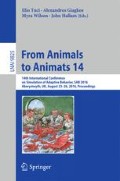Abstract
Robotic animals are regularly used in behavioral experiments, typically in experimental interactions with individuals of the species they were modelled on. In order to do so successfully, these robots need to be designed carefully, taking into consideration the specific perceptual system of the model species. We used marker-based motion capture to measure head bobbing in a widely popular lizard species, bearded dragons, and found that head bobbing is highly stereotypic yet differs subtly when displayed towards males and females. These results were then used for the construction of a robotic lizard, with the aim to use it in behavioral and cognitive studies, focusing on social cognition. This is the first study to use motion capture of head bobbing in lizards to inform the design of a robotic animal.
Access this chapter
Tax calculation will be finalised at checkout
Purchases are for personal use only
References
Frohnwieser, A., Murray, J., Pike, T., Wilkinson, A.: Using robots to understand animal cognition. J. Exp. Anal. Behav. 105, 14–22 (2016)
Fleishman, L.J., Endler, J.A.: Some comments on visual perception and the use of video playback in animal behavior studies. Acta Ethol. 3, 15–27 (2000)
Brattstrom, B.H.: Social and thermoregulatory behavior of the bearded dragon Amphibolurus barbatus. Copeia 1971(3), 484–497 (1971)
Kis, A., Huber, L., Wilkinson, A.: Social learning by imitation in a reptile (Pogona vitticeps). Anim. Cogn. 8(1), 325–331 (2014)
Abson, K., Palmer, I.: Motion capture: capturing interaction between human and animal. Vis. Comput. 31, 341–353 (2014)
Moro, F.L., Spröwitz, A., Tuleu, A., Vespignani, M., Tsagarakis, N.G., Ijspeert, A.J., Caldwell, D.G.: Horse-like walking, trotting, and galloping derived from kinematic motion primitives (kMPs) and their application to walk/trot transitions in a compliant quadruped robot. Biol. Cybern. 107, 309–320 (2013)
Hutchinson, J.: Outdoor Motion capture helps analyse kangaroo posture and hopping mechanisms (2010). http://www.vicon.com. Accessed 1 Mar 2016
Kim, C., Shin, H., Lee, H.: Trotting gait analysis of a lizard using motion capture. In: 2013 13th International Conference on Control, Automation and Systems (ICCAS 2013), pp. 1247–1251 (2013)
Kim, C., Shin, H., Jeong, T.: Motion analysis of lizard locomotion using motion capture. In: 2012 12th International Conference on Control, Automation and Systems, pp. 2143–2147 (2012)
Kim, H., Shin, H., Lee, H.: Trotting gait generation based on the lizard biometric data. Trans. Korean Inst. Electr. Eng. 62(10), 1436–1443 (2013)
Jenssen, T.A.: Display modifiers of Anolis Opalinus (Lacertilia: Iguanidae). Herpetologica 35(1), 21–30 (1979)
Lovern, M.B., Jenssen, T.A.: Form emergence and fixation of head bobbing displays in the green anole lizard (Anolis carolinensis): a reptilian model of signal ontogeny. J. Comp. Psychol. 117(2), 133–141 (2003)
Martins, E.P., Ord, T.J., Davenport, S.W.: Combining motions into complex displays: playbacks with a robotic lizard. Behav. Ecol. Sociobiol. 58, 351–360 (2005)
Macedonia, J.M., Stamps, J.A.: Species recognition in Anolis grahami (Sauria: Iguanidae): evidence from responses to video playbacks of conspecific and heterospecific displays. Ethology 98, 246–264 (1994)
Macedonia, J.M., Clark, D.L., Riley, R.G., Kemp, D.J.: Species recognition of color and motion signals in Anolis grahami: evidence from responses to lizard robots. Behav. Ecol. 24, 846–852 (2013)
Partan, S.R., Otovic, P., Price, V.L., Brown, S.E.: Assessing display variability in wild brown Anoles Anolis sagrei using a mechanical lizard model. Curr. Zool. 57, 140–152 (2011)
Smith, C.B., Martins, E.P.: Display plasticity in response to a robotic lizard: signal matching or song sharing in lizards? Ethology 112, 955–962 (2006)
Ord, T.J., Stamps, J.A.: Alert signals enhance animal communication in “noisy" environments. Proc. Natl. Acad. Sci. USA 105(48), 18830–18835 (2008)
Bels, V.L.: Analysis of the display-action-pattern of Anolis clorocyanus (Sauria: Iguanidae). Copeia 1986(4), 963–970 (1986)
Sellers, W.I., Hirasaki, E.: Markerless 3D motion capture for animal locomotion studies. Biol. Open. 3, 656–668 (2014)
Acknowledgements
The authors would like to thank Franky Mulloy, Joe Moore, Anthony Gorman and Sophie Moszuti for their help with data recording; Suzie Li Wan Po, Meredith Tise, Annali Beese, Matthew Walker and Manuel Jara for their involvement with creating the models and robot; and Dawn Simpson, Emma Huntbach and Hannah Thompson for animal care; and three anonymous reviewers for valuable input.
Author information
Authors and Affiliations
Corresponding authors
Editor information
Editors and Affiliations
Rights and permissions
Copyright information
© 2016 Springer International Publishing Switzerland
About this paper
Cite this paper
Frohnwieser, A., Willmott, A.P., Murray, J.C., Pike, T.W., Wilkinson, A. (2016). Using Marker-Based Motion Capture to Develop a Head Bobbing Robotic Lizard. In: Tuci, E., Giagkos, A., Wilson, M., Hallam, J. (eds) From Animals to Animats 14. SAB 2016. Lecture Notes in Computer Science(), vol 9825. Springer, Cham. https://doi.org/10.1007/978-3-319-43488-9_2
Download citation
DOI: https://doi.org/10.1007/978-3-319-43488-9_2
Published:
Publisher Name: Springer, Cham
Print ISBN: 978-3-319-43487-2
Online ISBN: 978-3-319-43488-9
eBook Packages: Computer ScienceComputer Science (R0)

